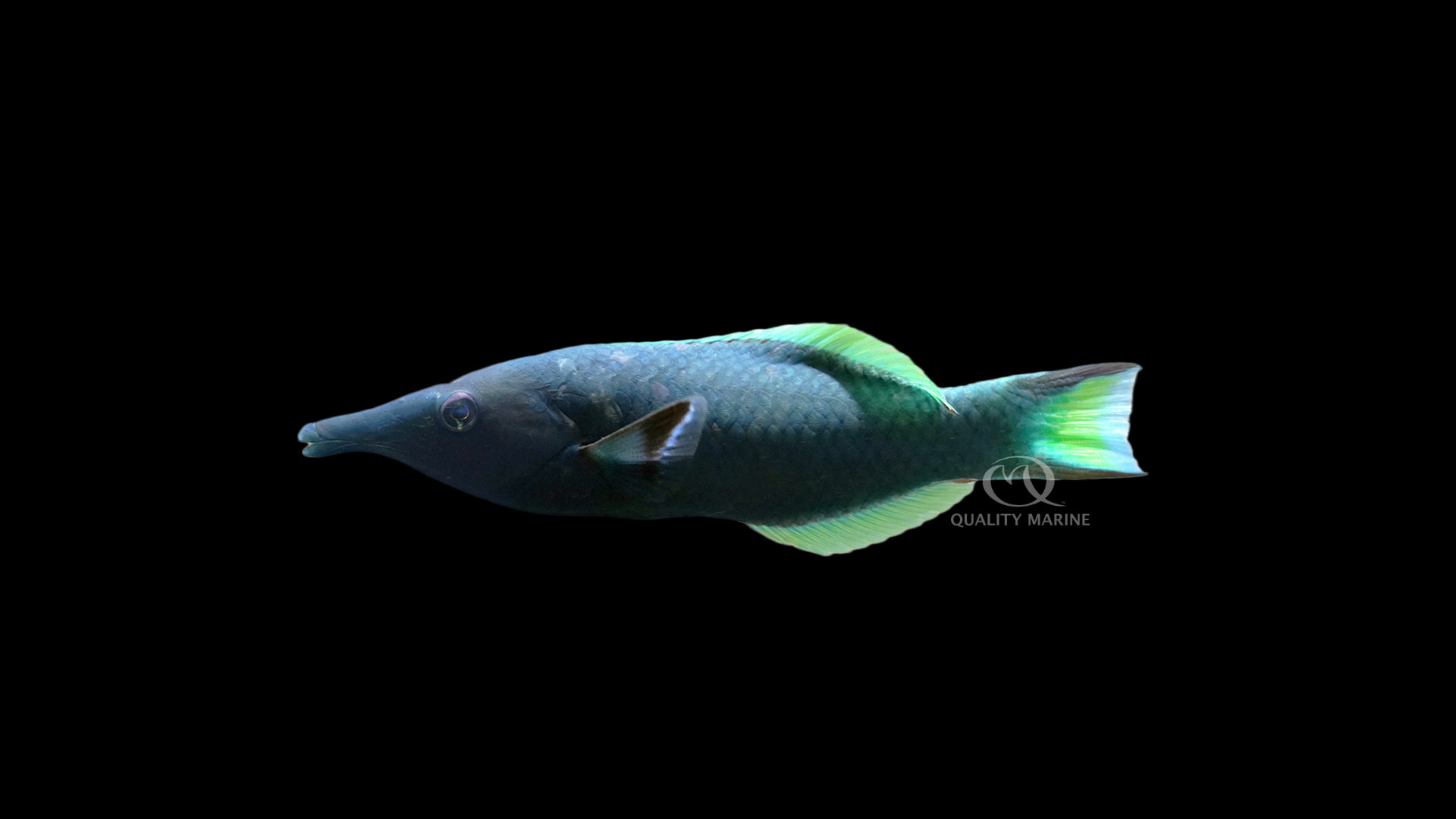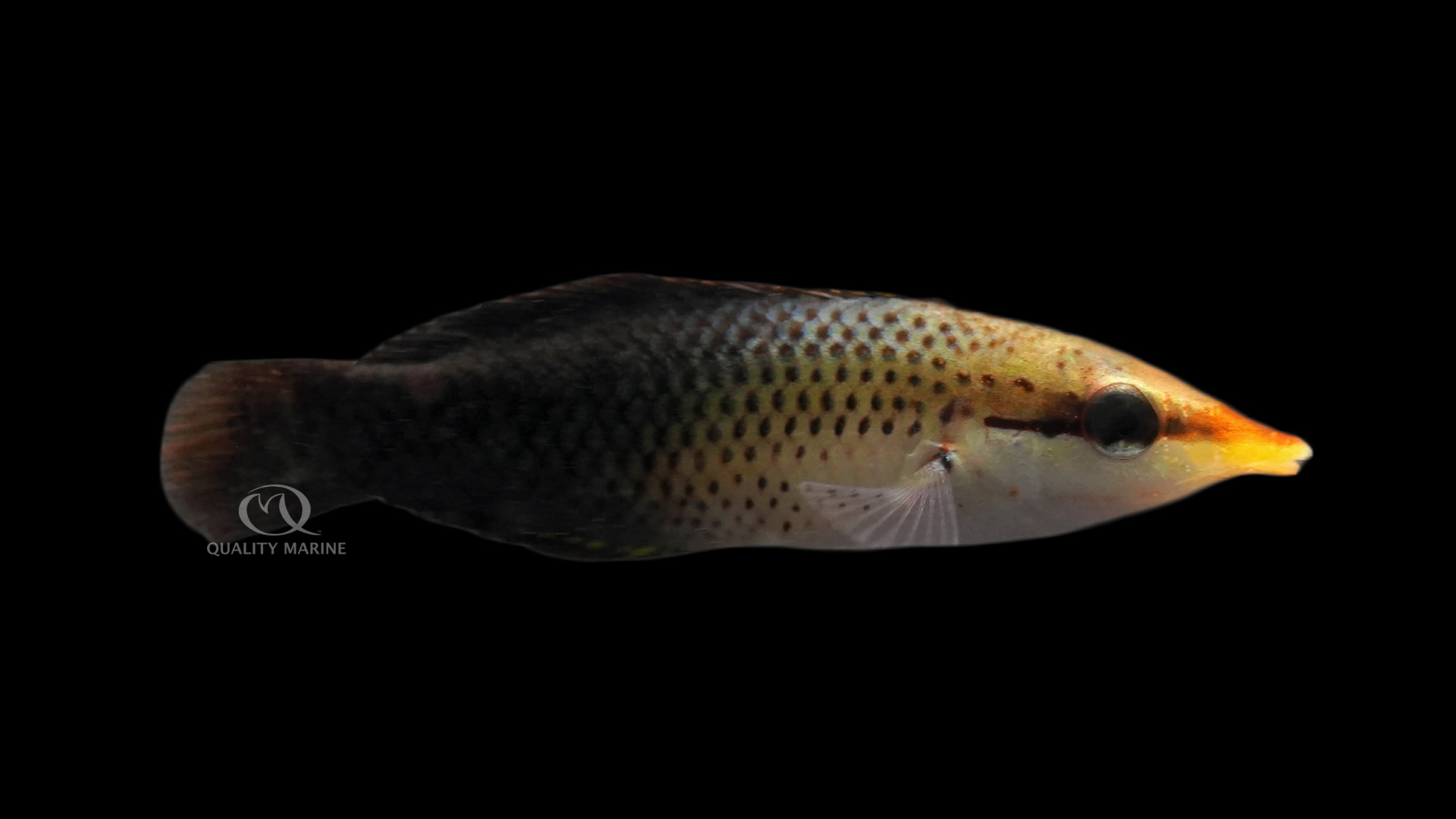The Bird Wrasse

The Bird Wrasse, (Gomphosus varius) is a member of the family Labridae, known commonly as the wrasses. A beautiful fish reaching a length of almost twelve inches, the Bird Wrasse, like all wrasses is a protogynous hermaphrodite. This means that all bird wrasses are born female, and then transition to males as they grow large enough and socially dominant enough in their territory. Bird Wrasses differ slightly in coloration depending on the collection point, but generally the smaller, juvenile or female coloration is a white underbelly, with a red rostrum, and fading to a darker olive brown color as it moves towards the back of the fish. Adult male fish display a beautiful mix of greenish blue hues with some pink and yellow accents. The name bird wrasse, originates from their large pectoral fins that they “flap” like bird wings as they move through the water and the very long rostrum, or the protruding snout of the fish that helps it extricate small invertebrates from cracks and crevices on the reef, such as within the branches of hard corals such as Acropora sp. They are known to hybridize with Thallasoma lunare in some places.
These fish are found throughout the Pacific Ocean and into the Indian Ocean. These fish are reef associated, and they are generally found on the reef crest. Here they can rapidly cruise in the currents searching for food in the rocky habitat. They can be found in knee deep water but their range does extend down to almost 100 feet! While they can be found from outer reefs, to lagoons – they are almost always associated with hard coral growth. They play an important role in these habitats, using their long snouts to delicately reach inside the branches of stoney corals to extricate small invertebrates living in the protection of these coral homes, some of which can bother the coral. Being a relatively large (12 inches) and very active fish, a large aquarium will eventually be necessary for the long-term care of these fish. A hundred- and eighty-gallon aquarium is a good size for an adult male bird wrasse, and if a singular wrasse is kept, they will all inevitably transition to a male as they grow and mature. Larger aquariums will result in more natural behavior and better long-term health. When selecting an aquarium for this fish, keep in mind that foot print is what matters, rather than volume – so select an aquarium that has the widest width and length possible. A suitable aquarium habitat would have open room for swimming, but simultaneously a lot of rocky areas to explore, hunt, and swim through. They could be displayed with SPS (small polyp stony corals, such as Acropora sp.) but remember that this is a larger, predatory fish. And while it would leave most fish alone, it will be on the hunt for invertebrates. If you are okay replacing your cleanup crew, and risking things like smaller shrimps or crabs, there’s no reason why this fish couldn’t be displayed with corals like the environment it is used to in the wild. A mature stoney coral aquarium would be an awesome way to display this fish, and might even allow for observing their natural hunting behavior – a sight few people can claim they’ve gotten to see in the home aquarium. Strong flow and current within the aquarium will help to keep this fish occupied and give it good exercise, again replicating the environments they are found in.

In the wild, these fish are carnivores and specifically target invertebrates. They play a role in maintaining the health of large stony coral colonies by using their long “beaks” to be able to eat inverts that live inside the corals, some of which will damage them over time. They will eat almost any invertebrate they can fit into their mouth from tubeworms to decorative clams. They also will flip over any loose pieces of rock, which is fine unless they are attached to corals. Keeping fragments of live rock, or larger coral skeletons on the sand bed is a great form of enrichment for these fish, who will “play” with these items as they cruise around and forage as they would in the wild during the day. Flipping over rocks on the reef to search for the invertebrates that live underneath them would be a common activity so expecting and allowing them to do this in the aquarium is a good idea.
Bird Wrasses have never been bred in the home aquarium, or commercially for the pet industry. During the mating season males will claim territories and defend them, displaying their value and the value of the location. Seaward locations are favored for mating as there are fewer other bird wrasses for competition (as opposed to further back on the reef, where other bird wrasse territories might surround you, offer competition, or even eat some of your eggs) and because these positions have the most current to pull eggs away and distribute them in the ocean. Females will enter these territories, and be courted by males, forming pairs or groups that will last for the duration of the mating season. The eggs are fertilized in the water column, and then drift until they hatch and settle out onto new reefs in new locations.
Bird Wrasses are truly stunning fish. Their unique morphology, bright and beautiful colorations, and active behavior make them a centerpiece fish for any display large enough to handle their size and activity levels. In a large enough aquarium, a single male could be added with a few females to follow later, creating an interesting social dynamic – and who knows, perhaps you will notice some courtship or spawning behaviors of your own! If you have a big tank, with plenty of current, and don’t mind Bird Wrasses desire to move rocks and sand while searching for and eating invertebrates – this fish might be a great choice for you. Mostly suitable to FOWLR (fish only with live rock) or very large reef tanks, call your local fish store and ask them to get you a sustainably sourced Bird Wrasse from Quality Marine today!